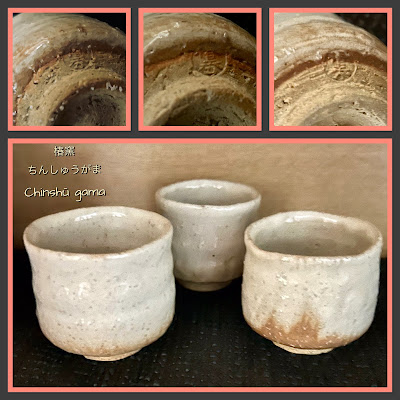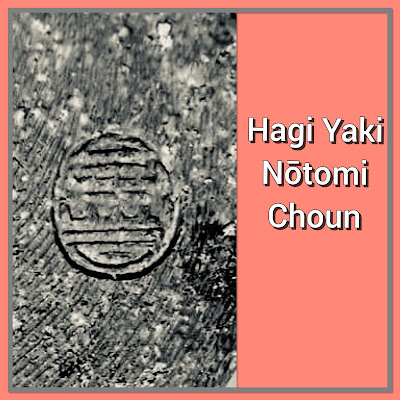There is an old Japanese saying when referring to the best pottery for the tea ceremony: "Ichi-raku, Ni-Hagi, San-Karatsu". First is raku, second Hagi and third Karatsu.
I learned from a friend that rough Hagi clay is called Oni- Hagi (鬼萩) and smooth is called Hime-Hagi (姫萩). Some of each are shown here.
Why the notched foot?
https://www.hagiyaki-kaikan.com/stories/高台の切り込みは何のため?/
*******************
Generic Hagi Marks
上手 急須 土瓶 Uwate kyusu dobin
萩燒 (燒 is an alternate form for yaki 焼, meaning to bake or for pottery to fire)

****************************************************************
CHIN SHU GAMA (椿秀窯)
AKA Shutōen kiln ( Master potter Sho Keiichirō)
Link: http://www.hagiyaki.co.jp/kaisha.html
This mottled look is called Gohonde which is a popular style in HAGI ware.
HAGIDONO GAMA (萩殿窯)
TENPOZAN ZO 天鵬山造
*Hara Shoun MARK
UNMARKED
HAGI RYUZAN (萩竜山)
TENPOZAN ZO 天鵬山造
 |
| Tenpozan Kiln |
 | ||||
Vase-Tenpozan
The master potter is Hirose Tanga. ********************************************************************** JYOZAN-GAMA |
|
|
| Box marked Shouraian, Jyozan Zo Cups marked Jyozan |
|
|
| Jozan-gama meoto "couple" teacup By Jyozan 城山 Jyozan kiln has many potters and support employees. The head of the kiln is Kaneko Nobuhiro |
********************************************************************
Marked Kasen 華扇
***********************************************************
SHOU-UN
*Hagi Yaki tea bowl by Shoun (祥雲)
*Hara Shoun MARK
Mr. Hara was born in Izumo, made Hagi and Izumo wares, later went to Kyoto, studied Korean pottery. He built a kiln in Uji, Kyoto named Seiwa Gama. Later wares carry the Seiwa Mark (清和).
Here is a box from the same tea bowl. It states Hagi Yaki made by Shoun.
UNMARKED







































Hello, I recently came across a Hagi ware set at a Good Will and purchased it for my 6 year old daughters birthday- not realizing what a treasure I had found. Do you have any suggestions for care? This is definitely something that she can use for a life time. Thank you, Laura Golden, CO USA
ReplyDeleteHAGI ware is rather unique in that it is rather porous. There are several sites that discuss the proper use and care of HAGI ware. Google it for detailed care instructions. It should never be put in a microwave or the dishwasher. It must be allowed to completely dry before packing away as it is prone to mold. The color of HAGI ware will change with use, but this is considered to part of the beauty of it. I hope your daughter will enjoy it for many years.
DeleteHello,
ReplyDeleteI got a really nice looking ochawan and am pretty sure it's Hagi ware. It came in a wooden box and the piece is signed by the artist. It has a beautiful shape and glaze. However, I haven't been able to identify the artist.
Please send photos of the chawan with Mark, along with photos of the marked box to:
DeleteMarmiet23@gmail.com
Thanks for your site. It was very interesting and helpful to me. Using your images I am pretty sure that I was able to identify a sake set made by Watanabe Jyozan of Jozan-gama. I have posted the set here:
ReplyDeletehttps://www.collectorsweekly.com/stories/282161-hagi-ware-jozan-gama-sake-set-by-watana
Feel free to use any of these images for your site, if I am correct in my identication.
Yes, as far as I can see I believe they are by Watanabe Jozan.
Delete